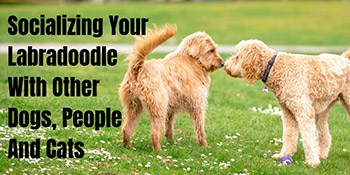Goldendoodles are still considered a new breed of dog despite being around for a few decades. These adorable “designer dogs” or “hybrids” first came to be in 1969 via a breeder named Monica Dickens.
Goldendoodles are a cross between the Golden Retriever and the Poodle.
Breeders in North America and Australia began crossing these two breeds intentionally in the 1990s, and Goldendoodles instantly became very popular.
Goldendoodles continue to be a popular combination even though there is no registry in existence.
It’s no surprise that this breed was such a welcome addition to the dog world since both the Poodle and the Golden Retriever have so many positive qualities.
Mixing them together only seemed to enhance the good qualities. Poodles are known as one of the most intelligent breeds while Golden Retrievers are friendly, affectionate and loving dogs.
Are Goldendoodles aggressive? No. They are generally not known for their aggression but for their loving nature. In some rare cases, a Goldendoodle may show signs of aggression, but these cases are usually the result of specific circumstances and/or lack of training and socialization. Aggression, particularly in a gentle-natured dog like the Goldendoodle, can be dealt with through patience, socialization, and consistent training.
While the chances of you getting a Goldendoodle who’s downright aggressive is probably pretty low, canine aggression comes in different forms and is triggered by different situations.
The focus of this article is to make you aware of the types of aggression and teach you how to identify the signals and behaviors before things turn ugly.
Of course you want the very best for your dog and are naturally concerned about potential issues, such as aggression or breed-related illnesses.
Because this breed is a combination of two purebred dogs, there’s a lot to learn as you need to take into account the characteristics of both parent breeds.
To make things as easy as possible for you and to ensure that you and your Goldendoodle get off to the best possible start, we’ve put together a comprehensive book to guide you along every aspect of your journey together.
The Owner’s Guide to the Perfect Goldendoodle explains all you need to know about raising your Goldendoodle.
All your questions pertaining to working with a breeder and selecting your puppy, preparing your home, training, grooming, shedding, health concerns, feeding, and more are answered in a clear and concise manner.
This book will be the only guide you need and will be the resource you turn to again and again. Grab your copy today!
Common Types of Dog Aggression
When we hear the words “dog aggression,” we automatically think of a dog growling or trying to bite someone or something.
We seldom take the time to determine what type of aggression it is or what’s causing the aggression.
However, it’s important to understand the type of aggression the dog is exhibiting. Is it normal? Is it misdirected?
Knowing the type of dog aggression a dog is having can make it easier to deal with the problem. Here are some common types of dog aggression and what might cause them.
Food
This is when a dog shows aggression around his food and may growl or even bite another dog or person who gets near his food.
This type of aggression often does not limit itself to the dog’s meal but may include doggie treats and even toys.
Food aggression is a very common type of dog aggression and can be very dangerous if not corrected.
Toward People
While it’s normal for a dog to bark at a stranger, there’s a difference between normal barking and being aggressive.
Aggression toward people can be more than just barking. It may include snapping, lip lifting, growling, lunging, and actually biting.
It’s very difficult to completely cure a dog of this type of aggression. It’s more a matter of controlling the situation, and professional help may be required.
Toward Other Dogs
Some dogs are aggressive only toward strange dogs while others are even aggressive toward dogs they know or even live in the same household with.
Aggression toward another dog is probably the most common type of dog aggression, but it can be aggravating and dangerous in a two-dog family. However, it’s also quite normal among dogs.
(Read about the pros and cons of having more than one dog in your family in this article.)
Toward Family Members
A dog showing aggression toward family members may be set off by any number of things, including fear, anger, dominance, or territorial dominance.
This type of aggression can be caused by many things and can also be frustrating and even dangerous if the situation is not kept under control and dealt with.
This 75+ page book is jam-packed with expert knowledge and real experiences from Goldendoodle owners and breeders alike. Consider this the ultimate owner’s guide for the breed with tips, tricks, and answers to the most frequently asked questions – saving you time, money, and loads of frustration along the way.
What Typically Causes These Aggressions?
Aggression may come for many different reasons. Some of it may be breed related, while other times it may come from some other situation or occurrence.
In the case of the Goldendoodle, which is typically a calm and good-natured dog, aggression usually has a specific cause or reason. The most common causes of dog aggression are:
- Fear –This is the most common cause of aggression. If a dog is afraid, aggression is his way to express himself.
- Illness or pain – A dog in pain may exhibit aggression to protect himself from other dogs or people.
- Frustration – Although it’s redirected, this type of aggression stems from the dog being frustrated over something he can’t get, have, or do.
- Protective – This is not a dog being a good watchdog but one that’s overprotective towards his family, home, or possessions.
- Leash aggression – A dog that is not properly leash trained will show aggression when walking on a leash.
- Social aggression – This aggression occurs when the dog is in a social situation where there are other dogs and people.
- Anxiety – This type of aggression may occur any time the dog is anxious about a person or situation.
- Resource or possession guarding – This type of aggression is when a dog is guarding what he perceives as “his property.” It may be a human, a dog treat, or even a toy.
Reducing the Likelihood of Aggressive Behaviors
Dogs may exhibit their aggression in different ways and for different reasons.
Often, knowing the signs that a dog is being aggressive or about to become aggressive can make it easier to nip it in the bud.
Signs a dog may be aggressive or headed toward aggression include:
- Snarling.
- Ears tucked back.
- Lunging.
- Eye aversion.
- Biting.
Training and socialization can play an important part in reducing the likelihood of dog aggression occurring regardless of the reason for the aggression.
How easy are Goldendoodles to train? You’ll find the answer here.
Eliminating the types of situations that may increase the likelihood of aggression can be a good first step towards training the dog to eliminate aggression.
If the dog shows aggression while entering the dog park, turn around, take the dog back to the car and wait until he calms down. If he doesn’t calm down, take him home.
If he does calm down, praise him, and try it again. Dogs are smart creatures and often quickly realize what behavior gets them treats or praise and what behavior doesn’t.
The earlier in life the dog gets training and socialization, the more effective they will be. There is a lot to be said for nipping aggression in the bud and providing positive reinforcement.
Few things make a dog happier than knowing their owner is happy with them. The dog should never be rewarded for inappropriate behavior.
For instance, a dog who is growling may be distracted from his growling by getting a treat. However, giving him the treat is like rewarding him for bad behavior.
Save the treats for training sessions and to reward good behavior and appropriate responses. Keep the treats tiny – you intention isn’t too provide a small meal here.
A tasty tidbit, like these natural, bite-size training treats are perfect as your dog will quickly learn to associate a good response with a yummy morsel.
If you offer a large snack, the dog will likely soon forget what he was rewarded for, and that would totally defeat the purpose.
Dealing With An Aggressive Goldendoodle
Dealing with an aggressive Goldendoodle may seem like an impossible task because Goldendoodles are normally so well mannered and loving, but it’s their personality that may make it easier.
You’ll find a wealth of information about Goldendoodle temperament on our Goldendoodle page. With over 30 articles on this amazing breed, your bound to learn something new. Access them all here.
Training and socialization at an early age can make a big difference. That cannot be overemphasized.
Puppies who are around well-behaved dogs will pick up on that behavior. A dog will seldom be aggressive with a well-mannered dog that’s minding his own business.
Keep in mind that Goldendoodles are very sensitive dogs.
Yelling at them and punishing them will not make the dog behave better but may increase the likelihood of the aggression happening again.
They respond much better with positive reinforcement training and praise. If the dog hasn’t had the proper socialization as a puppy, it’s still not too late.
Our Complete Guide to Socialization and downloadable checklist will help you understand the process and keep track of your and your dog’s progress.
It may take longer, but the dog will eventually understand what appropriate and inappropriate behavior is.
They love praise and will respond accordingly.
It may take a little longer to properly socialize an older Goldendoodle so he’s not aggressive, but it is possible, and the rewards will make it more than worth the work and effort.
Related Questions:
Do Goldendoodles Bark a Lot?
No, Goldendoodles do not bark a lot. They’re relatively quiet dogs by nature.
In fact, they are not considered a good watchdog because of how infrequently they bark. It has to be something pretty special or surprising to make a Goldendoodle bark.
Learn all about Goldendoodle barking, how to differentiate various barks, and how to correct excessive barking in this article.
What Causes Dogs to Growl and What Does It Mean?
Dogs will growl for a number of reasons. It’s their way of communicating their feelings.
Although fear is the most common reason for growling, they may also growl to express pain or exhibit territorial aggression. Some dogs even growl when they’re playing.
Knowing why the dog is growling is important and the first step towards correcting and eliminating the problem.
That’s A Wrap!
Goldendoodles are loving and wonderful dogs that make fantastic companions and family pets.
Proper socialization and consistent training can ensure this dog does not exhibit inappropriate aggression and grows up to be the kind of dog who has made this hybrid so popular worldwide.
Don’t miss out on key insights, advice, and breed-specific information about these intelligent, loving dogs.
Pick up your copy of our Complete Goldendoodle Guide today to ensure that your Doodle will grow up to be the amazing dog he was destined to be.
Last update on 2024-04-16 at 18:01 / Affiliate links / Images from Amazon Product Advertising API







